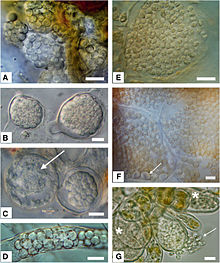| Maullinia | |
|---|---|

| |
| E: Resting spores of Maullinia sp. resting spores in Durvillaea antarctica | |
| Scientific classification | |
| Domain: | Eukaryota |
| Clade: | Diaphoretickes |
| Clade: | SAR |
| Phylum: | Endomyxa |
| Class: | Phytomyxea |
| Order: | Phagomyxida |
| Family: | Phagomyxidae |
| Genus: | Maullinia I. Maier, E. R. Parodi, R. Wester-meier et D. G. Müller 2000 |
Maullinia is a genus of intracellular, phytomyxid parasites found across the Southern Hemisphere though primarily in Chile, The Prince Edward Islands, South Africa, Australia, and New Zealand.[1][2][3][4][5] These parasites infiltrate the cells of their brown algal hosts via cytoplasmic extensions called plasmodia that divide synchronously,[1] becoming increasingly multi-nucleate and engulfing the host cell organelles as they grow.[1][3] Eventually, as the plasmodia fill the entire cell volume, the host cells become hypertrophied and grow to 3- 4x their original size,[2] showing up as swollen appendages or galls on the host tissue at a macroscopic level.[1][3] These swollen regions will burst alongside the mature Maullinia plasmodia, releasing biflagellated zoospores to the inter- and extracellular space to disperse the infection further.[6] Zoospores can come from sporangial plasmodia,[1] as in M. ectocarpii, or from resting spores, as in M. braseltonii.[3]
As Maullinia can infect a wide range commercially important brown algal hosts, they present a significant threat to kelp farming and mariculture efforts.[1] These infections could also cause significant harm on a global scale to natural populations, as they are able to disperse over long distances via rafting and tend to thrive in the cooler waters where kelp are often found.[4][5]
- ^ a b c d e f Maier, Ingo; Parodi, Elisa; Westermeier, Renato; Müller, Dieter G. (2000-10-01). "Maullinia ectocarpii gen. et sp. nov. (Plasmodiophorea), an Intracellular Parasite in Ectocarpus siliculosus (Ectocarpales, Phaeophyceae) and other Filamentous Brown Algae". Protist. 151 (3): 225–238. doi:10.1078/1434-4610-00021. hdl:11336/30413. ISSN 1434-4610. PMID 11079768.
- ^ a b Goecke, Franz; Wiese, Jutta; Núñez, Alejandra; Labes, Antje; Imhoff, Johannes F.; Neuhauser, Sigrid (2012-09-17). Waller, Ross Frederick (ed.). "A Novel Phytomyxean Parasite Associated with Galls on the Bull-Kelp Durvillaea antarctica (Chamisso) Hariot". PLOS ONE. 7 (9): e45358. doi:10.1371/journal.pone.0045358. ISSN 1932-6203. PMC 3444446. PMID 23028958.
- ^ a b c d Murúa, Pedro; Goecke, Franz; Westermeier, Renato; van West, Pieter; Küpper, Frithjof C.; Neuhauser, Sigrid (2017-08-01). "Maullinia braseltonii sp. nov. (Rhizaria, Phytomyxea, Phagomyxida): A Cyst-forming Parasite of the Bull Kelp Durvillaea spp. (Stramenopila, Phaeophyceae, Fucales)". Protist. 168 (4): 468–480. doi:10.1016/j.protis.2017.07.001. ISSN 1434-4610. PMC 5673062. PMID 28822911.
- ^ a b Blake, Callum; Thiel, Martin; López, Boris A.; Fraser, Ceridwen I. (2017-11-16). "Gall-forming protistan parasites infect southern bull kelp across the Southern Ocean, with prevalence increasing to the south". Marine Ecology Progress Series. 583: 95–106. doi:10.3354/meps12346. hdl:1885/238283. ISSN 0171-8630.
- ^ a b Mabey, Abigail L.; Parvizi, Elahe; Fraser, Ceridwen I. (2021-03-18). "Pathogen inferred to have dispersed thousands of kilometres at sea, infecting multiple keystone kelp species". Marine Biology. 168 (4): 47. doi:10.1007/s00227-021-03853-8. ISSN 1432-1793. S2CID 233533212.
- ^ Parodi, Elisa Rosalia; Caceres, Eduardo Jorge; Westermeier, Renato; Muller, Dieter G. (2010-02-01). "Secondary zoospores in the algal endoparasite Maullinia ectocarpii (Plasmodiophorea)". Biocell. 34 (1): 45–52. ISSN 0327-9545.